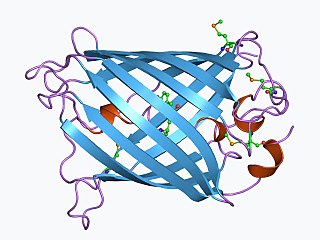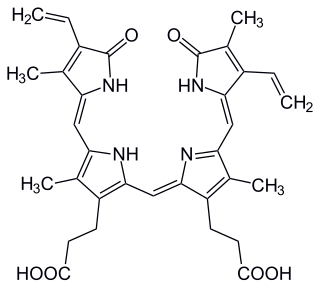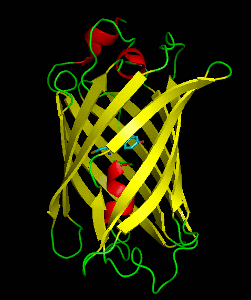Related Research Articles

The green fluorescent protein (GFP) is a protein that exhibits green fluorescence when exposed to light in the blue to ultraviolet range. The label GFP traditionally refers to the protein first isolated from the jellyfish Aequorea victoria and is sometimes called avGFP. However, GFPs have been found in other organisms including corals, sea anemones, zoanithids, copepods and lancelets.

Behavioral neuroscience, also known as biological psychology, biopsychology, or psychobiology, is the application of the principles of biology to the study of physiological, genetic, and developmental mechanisms of behavior in humans and other animals.

Chemical biology is a scientific discipline between the fields of chemistry and biology. The discipline involves the application of chemical techniques, analysis, and often small molecules produced through synthetic chemistry, to the study and manipulation of biological systems. Although often confused with biochemistry, which studies the chemistry of biomolecules and regulation of biochemical pathways within and between cells, chemical biology remains distinct by focusing on the application of chemical tools to address biological questions.

Biliverdin is a green tetrapyrrolic bile pigment, and is a product of heme catabolism. It is the pigment responsible for a greenish color sometimes seen in bruises.

A molecular sensor or chemosensor is a molecular structure that is used for sensing of an analyte to produce a detectable change or a signal. The action of a chemosensor, relies on an interaction occurring at the molecular level, usually involves the continuous monitoring of the activity of a chemical species in a given matrix such as solution, air, blood, tissue, waste effluents, drinking water, etc. The application of chemosensors is referred to as chemosensing, which is a form of molecular recognition. All chemosensors are designed to contain a signalling moiety and a recognition moiety, that is connected either directly to each other or through a some kind of connector or a spacer. The signalling is often optically based electromagnetic radiation, giving rise to changes in either the ultraviolet and visible absorption or the emission properties of the sensors. Chemosensors may also be electrochemically based. Small molecule sensors are related to chemosensors. These are traditionally, however, considered as being structurally simple molecules and reflect the need to form chelating molecules for complexing ions in analytical chemistry. Chemosensors are synthetic analogues of biosensors, the difference being that biosensors incorporate biological receptors such as antibodies, aptamers or large biopolymers.

Roger Yonchien Tsien was an American biochemist. He was a professor of chemistry and biochemistry at the University of California, San Diego and was awarded the Nobel Prize in Chemistry in 2008 for his discovery and development of the green fluorescent protein, in collaboration with organic chemist Osamu Shimomura and neurobiologist Martin Chalfie. Tsien was also a pioneer of calcium imaging.
Alice Yen-Ping Ting is Taiwanese-born American chemist. She is a professor of genetics, of biology, and by courtesy, of chemistry at Stanford University. She is also a Chan Zuckerberg Biohub investigator and a member of the National Academy of Sciences.
TimeSTAMP is a technique invented by Michael Z. Lin at the Roger Tsien lab at the University of California, San Diego in 2008. It is a technique that can specifically label the newly synthesized copies of the genetically tagged protein.

The reduction-oxidation sensitive green fluorescent protein (roGFP) is a green fluorescent protein engineered to be sensitive to changes in the local redox environment. roGFPs are used as redox-sensitive biosensors.

Edward S. Boyden is an American neuroscientist and entrepreneur at MIT. He is the Y. Eva Tan Professor in Neurotechnology, and a full member of the McGovern Institute for Brain Research. He is recognized for his work on optogenetics and expansion microscopy. Boyden joined the MIT faculty in 2007, and continues to develop new optogenetic tools as well as other technologies for the manipulation and analysis of brain structure and activity. He received the 2015 Breakthrough Prize in Life Sciences.

GCaMP is a genetically encoded calcium indicator (GECI) initially developed in 2001 by Junichi Nakai. It is a synthetic fusion of green fluorescent protein (GFP), calmodulin (CaM), and M13, a peptide sequence from myosin light-chain kinase. When bound to Ca2+, GCaMP fluoresces green with a peak excitation wavelength of 480 nm and a peak emission wavelength of 510 nm. It is used in biological research to measure intracellular Ca2+ levels both in vitro and in vivo using virally transfected or transgenic cell and animal lines. The genetic sequence encoding GCaMP can be inserted under the control of promoters exclusive to certain cell types, allowing for cell-type specific expression of GCaMP. Since Ca2+ is a second messenger that contributes to many cellular mechanisms and signaling pathways, GCaMP allows researchers to quantify the activity of Ca2+-based mechanisms and study the role of Ca2+ ions in biological processes of interest.

Dronpa is a reversibly switchable photoactivatable fluorescent protein that is 2.5 times as bright as EGFP. Dronpa gets switched off by strong illumination with 488 nm (blue) light and this can be reversed by weak 405 nm UV light. A single dronpa molecule can be switched on and off over 100 times. It has an excitation peak at 503 nm and an emission peak at 518 nm.

FlAsH-EDT2 is an organoarsenic compound with molecular formula C24H18As2O5S4. Its structure is based around a fluorescein core with two 1,3,2-dithiarsolane substituents. It is used in bioanalytical research as a fluorescent label for visualising proteins in living cells. FlAsH-EDT2 is an abbreviation for fluorescin arsenical hairpin binder-ethanedithiol, and is a pale yellow or pinkish fluorogenic solid. It has a semi-structural formula (C2H4AsS2)2-(C13H5O3)-C6H4COOH, representing the dithiarsolane substituents bound to the hydroxyxanthone core, attached to an o-substituted molecule of benzoic acid.
Calcium imaging is a microscopy technique to optically measure the calcium (Ca2+) status of an isolated cell, tissue or medium. Calcium imaging takes advantage of calcium indicators, fluorescent molecules that respond to the binding of Ca2+ ions by fluorescence properties. Two main classes of calcium indicators exist: chemical indicators and genetically encoded calcium indicators (GECI). This technique has allowed studies of calcium signalling in a wide variety of cell types. In neurons, action potential generation is always accompanied by rapid influx of Ca2+ ions. Thus, calcium imaging can be used to monitor the electrical activity in hundreds of neurons in cell culture or in living animals, which has made it possible to observe the activity of neuronal circuits during ongoing behavior.

HaloTag is a self-labeling protein tag. It is a 297 residue protein derived from a bacterial enzyme, designed to covalently bind to a synthetic ligand. The bacterial enzyme can be fused to various proteins of interest. The synthetic ligand is chosen from a number of available ligands in accordance with the type of experiments to be performed. This bacterial enzyme is a haloalkane dehalogenase, which acts as a hydrolase and is designed to facilitate visualization of the subcellular localization of a protein of interest, immobilization of a protein of interest, or capture of the binding partners of a protein of interest within its biochemical environment. The HaloTag is composed of two covalently bound segments including a haloalkane dehalogenase and a synthetic ligand of choice. These synthetic ligands consist of a reactive chloroalkane linker bound to a functional group. Functional groups can either be biotin or can be chosen from five available fluorescent dyes including Coumarin, Oregon Green, Alexa Fluor 488, diAcFAM, and TMR. These fluorescent dyes can be used in the visualization of either living or chemically fixed cells.

Small ultra red fluorescent protein (smURFP) is a class of far-red fluorescent protein evolved from a cyanobacterial phycobiliprotein, α-allophycocyanin. Native α-allophycocyanin requires an exogenous protein, known as a lyase, to attach the chromophore, phycocyanobilin. Phycocyanobilin is not present in mammalian cells. smURFP was evolved to covalently attach phycocyanobilin without a lyase and fluoresce, covalently attach biliverdin and fluoresce, blue-shift fluorescence to match the organic fluorophore, Cy5, and not inhibit E. coli growth. smURFP was found after 12 rounds of random mutagenesis and manually screening 10,000,000 bacterial colonies.
Genetically encoded voltage indicator is a protein that can sense membrane potential in a cell and relate the change in voltage to a form of output, often fluorescent level. It is a promising optogenetic recording tool that enables exporting electrophysiological signals from cultured cells, live animals, and ultimately human brain. Examples of notable GEVIs include ArcLight, ASAP1, ASAP3, Archons, SomArchon, and Ace2N-mNeon.
A genetically engineered fluorescent protein that changes its fluorescence when bound to the neurotransmitter glutamate. Glutamate-sensitive fluorescent reporters are used to monitor the activity of presynaptic terminals by fluorescence microscopy. GluSnFRs are a class of optogenetic sensors used in neuroscience research. In brain tissue, two-photon microscopy is typically used to monitor GluSnFR fluorescence.
Jin Zhang is a Chinese-American biochemist. She is a professor of pharmacology, chemistry and biochemistry, and biomedical engineering at the University of California, San Diego.
Optogenetics began with methods to alter neuronal activity with light, using e.g. channelrhodopsins. In a broader sense, optogenetic approaches also include the use of genetically encoded biosensors to monitor the activity of neurons or other cell types by measuring fluorescence or bioluminescence. Genetically encoded calcium indicators (GECIs) are used frequently to monitor neuronal activity, but other cellular parameters such as membrane voltage or second messenger activity can also be recorded optically. The use of optogenetic sensors is not restricted to neuroscience, but plays increasingly important roles in immunology, cardiology and cancer research.
References
- ↑ "Michael Lin's Profile | Stanford Profiles". profiles.stanford.edu.
- ↑ "Chemistry Tree - Michael Z. Lin". academictree.org.
- ↑ "Michael Lin's Profile | Stanford Profiles". profiles.stanford.edu.
- ↑ "Chemistry Tree - Michael Z. Lin". academictree.org.
- ↑ Shaner, N. C.; Lin, M. Z.; McKeown, M. R.; Steinbach, P. A.; Hazelwood, K. L.; Davidson, M. W.; Tsien, R. Y. (2008). "Improving the photostability of bright monomeric orange and red fluorescent proteins". Nature Methods. 5 (6): 545–51. doi:10.1038/nmeth.1209. PMC 2853173 . PMID 18454154.
- ↑ Lin, M. Z.; McKeown, M. R.; Ng, H. L.; Aguilera, T. A.; Shaner, N. C.; Campbell, R. E.; Adams, S. R.; Gross, L. A.; Ma, W.; Alber, T.; Tsien, R. Y. (2009). "Autofluorescent proteins with excitation in the optical window for intravital imaging in mammals". Chemistry & Biology. 16 (11): 1169–79. doi:10.1016/j.chembiol.2009.10.009. PMC 2814181 . PMID 19942140.
- ↑ Lin, J. Y.; Lin, M. Z.; Steinbach, P.; Tsien, R. Y. (2009). "Characterization of engineered channelrhodopsin variants with improved properties and kinetics". Biophysical Journal. 96 (5): 1803–14. Bibcode:2009BpJ....96.1803L. doi:10.1016/j.bpj.2008.11.034. PMC 2717302 . PMID 19254539.
- ↑ Chu, J.; Oh, Y.; Sens, A.; Ataie, N.; Dana, H.; MacKlin, J. J.; Laviv, T.; Welf, E. S.; Dean, K. M.; Zhang, F.; Kim, B. B.; Tang, C. T.; Hu, M.; Baird, M. A.; Davidson, M. W.; Kay, M. A.; Fiolka, R.; Yasuda, R.; Kim, D. S.; Ng, H. L.; Lin, M. Z. (2016). "A bright cyan-excitable orange fluorescent protein facilitates dual-emission microscopy and enhances bioluminescence imaging in vivo". Nature Biotechnology. 34 (7): 760–7. doi:10.1038/nbt.3550. PMC 4942401 . PMID 27240196.
- ↑ Gitig, Diana (9 November 2016). "Watching a cell cycle". Ars Technica.
- ↑ "Phosphorylation at the Flick of a Switch". The Scientist Magazine.
- ↑ Zhou, XX; Fan, LZ; Li, P; Shen, K; Lin, MZ (24 February 2017). "Optical control of cell signaling by single-chain photoswitchable kinases". Science. 355 (6327): 836–842. Bibcode:2017Sci...355..836Z. doi:10.1126/science.aah3605. PMC 5589340 . PMID 28232577.
- ↑ Vogt, Nina (January 2020). "RAMPing up voltage indicator imaging". Nature Methods. 17 (1): 25. doi: 10.1038/s41592-019-0720-4 . PMID 31907465. S2CID 209897141.
- ↑ Villette, V; Chavarha, M; Dimov, IK; Bradley, J; Pradhan, L; Mathieu, B; Evans, SW; Chamberland, S; Shi, D; Yang, R; Kim, BB; Ayon, A; Jalil, A; St-Pierre, F; Schnitzer, MJ; Bi, G; Toth, K; Ding, J; Dieudonné, S; Lin, MZ (12 December 2019). "Ultrafast Two-Photon Imaging of a High-Gain Voltage Indicator in Awake Behaving Mice". Cell. 179 (7): 1590–1608.e23. doi:10.1016/j.cell.2019.11.004. PMC 6941988 . PMID 31835034.
- ↑ Chung, H. K.; Jacobs, C. L.; Huo, Y.; Yang, J.; Krumm, S. A.; Plemper, R. K.; Tsien, R. Y.; Lin, M. Z. (2015). "Tunable and reversible drug control of protein production via a self-excising degron". Nature Chemical Biology. 11 (9): 713–20. doi:10.1038/nchembio.1869. PMC 4543534 . PMID 26214256.
- ↑ Jacobs, C. L.; Badiee, R. K.; Lin, M. Z. (2018). "StaPLs: Versatile genetically encoded modules for engineering drug-inducible proteins". Nature Methods. 15 (7): 523–526. doi:10.1038/s41592-018-0041-z. PMC 6456726 . PMID 29967496.
- ↑ "Synthetic Protein for Targeted Cancer Therapy". BioTechniques. 14 May 2019.
- ↑ Chung, HK; Zou, X; Bajar, BT; Brand, VR; Huo, Y; Alcudia, JF; Ferrell JE, Jr; Lin, MZ (3 May 2019). "A compact synthetic pathway rewires cancer signaling to therapeutic effector release". Science. 364 (6439): eaat6982. doi:10.1126/science.aat6982. PMC 7053279 . PMID 31048459.
- ↑ Westberg, Michael; Su, Yichi; Zou, Xinzhi; Ning, Lin; Hurst, Brett; Tarbet, Bart; Lin, Michael Z. (2020-09-16). "Rational design of a new class of protease inhibitors for the potential treatment of coronavirus diseases". bioRxiv: 2020.09.15.275891. doi:10.1101/2020.09.15.275891. S2CID 221823586.
- ↑ "2011-2007 Awardees | Burroughs Wellcome Fund". www.bwfund.org.
- ↑ "Michael Lin". Rita Allen Foundation.
- ↑ "World Molecular Imaging Society Announces Early Stage Awardees for 2019". World Molecular Imaging Society. 12 September 2019.